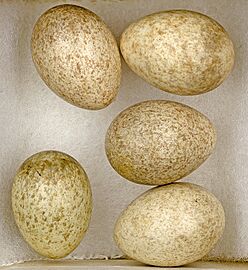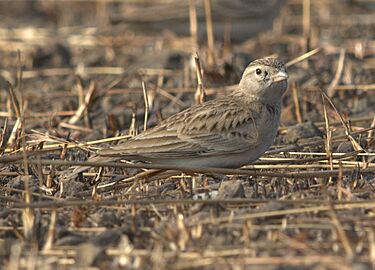Greater short-toed lark facts for kids
Quick facts for kids Greater short-toed lark |
|
|---|---|
 |
|
| from Mangaon, Maharashtra, India | |
| Conservation status | |
| Scientific classification | |
| Genus: |
Calandrella
|
| Species: |
brachydactyla
|
| Subspecies | |
|
See text |
|
 |
|
| Range of C. brachydactyla Breeding Resident Passage Non-breeding | |
| Synonyms | |
|
|
The greater short-toed lark (Calandrella brachydactyla) is a small passerine bird. This means it is a type of perching bird. Its scientific name comes from Ancient Greek. Calandrella means "little calandra lark". Brachydactyla means "short-toed," which describes its feet.
These birds make their homes in southern Europe, north-west Africa, and across a large area from Turkey to Mongolia. This area is called the Palearctic. When they travel, they fly in big, close groups. At other times, they form looser groups.
Contents
About the Greater Short-toed Lark
How the Lark Got Its Name
The greater short-toed lark was first described in 1814. A German naturalist named Johann Leisler gave it the name Alauda brachydactila. Later, another German naturalist, Johann Jakob Kaup, placed it in the genus Calandrella.
The name brachydactyla comes from two Ancient Greek words. Brakhus means "short" and daktulos means "toe." So, the name simply means "short-toed." Other birds in the Calandrella group also have "short-toed lark" in their names.
Different Types of Greater Short-toed Larks
There are eight different types, or subspecies, of the greater short-toed lark. These groups live in different parts of the world.
- European greater short-toed lark (C. b. brachydactyla): Found in southern Europe, Mediterranean islands, and north-western Africa.
- Hungarian greater short-toed lark (C. b. hungarica): Lives in Hungary and northern Serbia.
- North African greater short-toed lark (C. b. rubiginosa): Found in northern Africa.
- Levant greater short-toed lark (C. b. hermonensis): Lives from southern Turkey and Syria to north-eastern Egypt.
- BIrelandcik greater short-toed lark (C. b. woltersi): Found in southern Turkey and north-western Syria.
- Transcaucasian greater short-toed lark (C. b. artemisiana): Lives from central Turkey and Transcaucasia to north-western Iran.
- Steppe greater short-toed lark (C. b. longipennis): Found from Ukraine and southern Russia to southern Mongolia. It is also known as the Eastern short-toed lark.
- C. b. orientalis: Lives in central Siberia, northern Mongolia, and northern China.
What the Greater Short-toed Lark Looks Like
This lark is a small, pale bird. It is smaller than the common skylark. Its back is greyish-brown with dark streaks. Its belly is white. It has a strong, pointed beak that is pinkish with a grey top.
You can spot a pale stripe above its eye. It also has dark patches on each side of its neck. Its tail is dark. Some larks in the western areas have a reddish-brown top of the head. Male and female larks look very similar.
The greater short-toed lark is lighter in color than the Mongolian short-toed lark. The Mongolian lark also has a shorter beak. In winter, these birds fly in large, tight groups. These groups move together in a synchronized way.
Sounds and Habits
The song of the greater short-toed lark can change. It might be a quick, dry chirping sound. Or it can be a more varied and musical tune. Large groups of these birds often fly to water sources in the mornings.
In the evenings, they rest on open ground. Each bird finds a small dip in the soil to settle into.
Where Greater Short-toed Larks Live
Habitat and Migration
Most greater short-toed larks are migratory. This means they travel long distances. They spend their winters in warmer places. These include the southern edge of the Sahara desert and India.
This bird sometimes wanders to northern and western Europe. This happens during spring and autumn. Birds that live in Spain and Portugal spend their winters south of the Sahara in Africa. They like farmland and dry fields with short bushes.
Diet and Nesting
The greater short-toed lark is a common bird in dry, open areas and farmlands. It builds its nest on the ground. The female bird usually lays two or three eggs.
Their main food is seeds. They also eat insects, especially during the breeding season. In winter, large groups of these birds visit parts of South Asia. They are sometimes drawn to short grass areas near airports. This can be a risk to aircraft.





